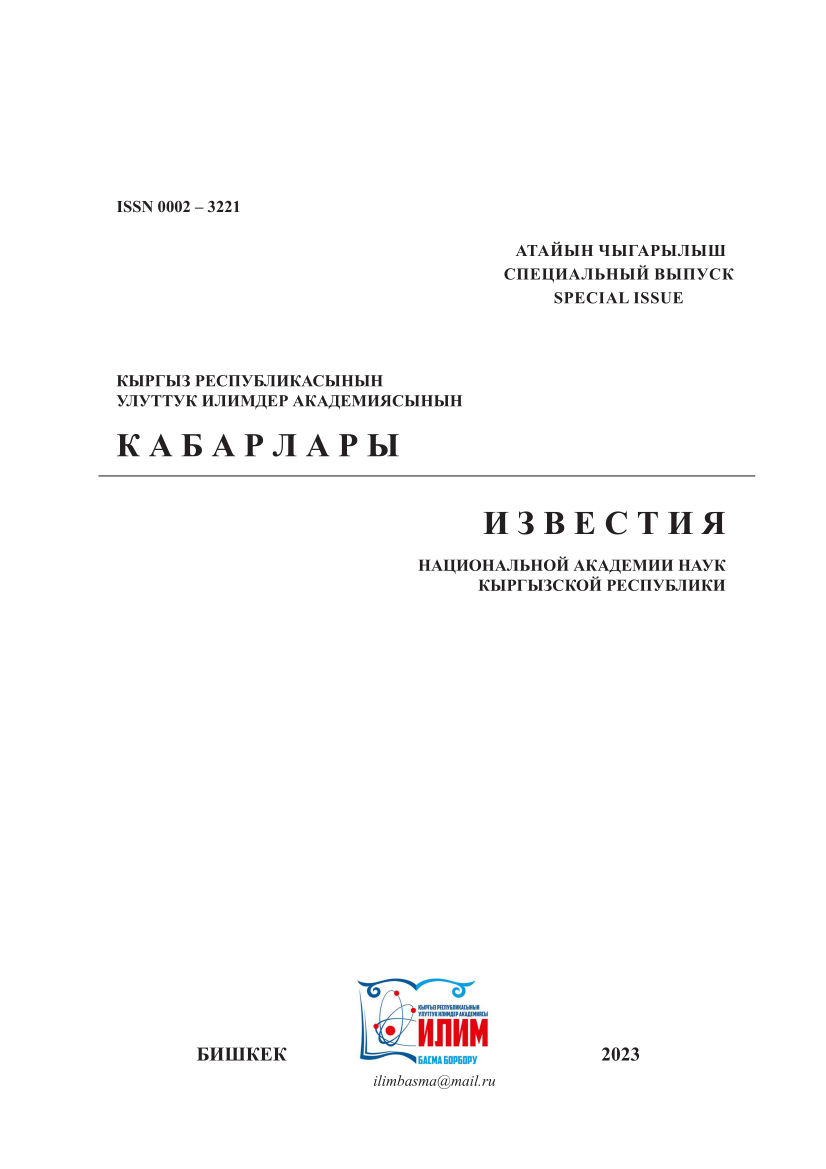ASSESSMENT OF THE ECOLOGICAL STATE OF WATER OF LAKE ISSYK-KUL BY TROPHIC STATE INDEX (TSI)
Keywords:
eutrophication, ecological assessment of ecosystems, sustainable development, trophic status, pollution of water bodies.Abstract
Implementation of complex assessment of the ecological state of water of Lake
Issyk-Kul and development of effective measures and recommendations on preservation of ecological balance of the lake ecosystem is an actual task of scientists of ecologists of the country. The
country has long-term monitoring analyses, but there is a need for their processing and carrying
out predictive analyses. One of such techniques is the index of trophic level of lake water. Analyses have shown that the trophic status of the lake is subject to temporal and spatial changes. In
general, the lake belongs to oligotrophic water body by trophic status, where the main biogenic
elements are low and do not exceed MAC in water. But, according to the trophic state index, c.
Chok-Tal is assessed as the most polluted region, in the study sites of Balykchy, Cholpon-Ata,
Grigorievka and Bosteri there is a change in the trophic state of aquatic ecosystems from oligotrophic to mesotrophic. This indicates an increase in the concentration of nutrients such as nitrogen
and phosphorus in aquatic systems. The use of the trophic state index allows assessing the water
quality of the lake in a more detailed and comprehensive manner and is recommended for its wide
application by both industrial and research workers.
References
Choi, J. W., Han, J. H., Park, C. S., Ko, D. G., Kang, H. I., Kim, J. Y., ... & An, K. G. (2015).
Nutrients and sestonic chlorophyll dynamics in Asian lotic ecosystems and ecological stream
health in relation to land-use patterns and water chemistry. Ecological Engineering, 79, 15-31.
Bilgin, A. (2020). Trophic state and limiting nutrient evaluations using trophic state/level
index methods: a case study of Borçka Dam Lake. Environmental Monitoring and Assessment, 192,
-19.
Ding, J., Jiang, Y., Fu, L., Liu, Q., Peng, Q., & Kang, M. (2015). Impacts of land use on
surface water quality in a subtropical river basin: a case study of the dongjiang river basin, Southeastern China. Water (Switzerland). https://doi. org/10.3390/w7084427
Wang, Y., Kong, X., Peng, Z., Zhang, H., Liu, G., Hu, W., & Zhou, X. (2020). Retention
of nitrogen and phosphorus in Lake Chaohu, China: implications for eutrophication management. Environmental Science and Pollution Research, 27, 41488-41502.
Kast, J. B., Apostel, A. M., Kalcic, M. M., Muenich, R. L., Dagnew, A., Long, C. M., ... &
Martin, J. F. (2021). Source contribution to phosphorus loads from the Maumee River watershed
to Lake Erie. Journal of Environmental Management, 279, 111803.
Dodds, W. K., & Smith, V. H. (2016). Nitrogen, phosphorus, and eutrophication in
streams. Inland Waters, 6(2), 155-164.
Le Moal, M., Gascuel-Odoux, C., Ménesguen, A., Souchon, Y., Étrillard, C., Levain,
A., ... & Pinay, G. (2019). Eutrophication: a new wine in an old bottle?. Science of the total
environment, 651, 1-11.
Liu, L., Zheng, X., Wei, X., Kai, Z., & Xu, Y. (2021). Excessive application of chemical
fertilizer and organophosphorus pesticides induced total phosphorus loss from planting causing
surface water eutrophication. Scientific Reports, 11(1), 23015.
Chalar, G., Arocena, R., Pacheco, J. P., & Fabián, D. (2011). Trophic assessment of streams
in Uruguay: a trophic State Index for Benthic Invertebrates (TSI-BI). Ecological Indicators, 11(2),
-369.
Chalar, G., Delbene, L., González-Bergonzoni, I., & Arocena, R. (2013). Fish assemblage changes along a trophic gradient induced by agricultural activities (Santa Lucía, Uruguay). Ecological Indicators, 24, 582-588.
Vinçon-Leite, B., & Casenave, C. (2019). Modelling eutrophication in lake ecosystems: a
review. Science of the Total Environment, 651, 2985-3001.
Janssen, A. B., Hilt, S., Kosten, S., de Klein, J. J., Paerl, H. W., & Van de Waal, D. B.
(2021). Shifting states, shifting services: Linking regime shifts to changes in ecosystem services
of shallow lakes. Freshwater Biology, 66(1), 1-12.
Adamovich, B. V., Medvinsky, A. B., Nikitina, L. V., Radchikova, N. P., Mikheyeva, T. M.,
Kovalevskaya, R. Z., ... & Zhukova, T. V. (2019). Relations between variations in the lake bacterioplankton abundance and the lake trophic state: Evidence from the 20-year monitoring. Ecological
indicators, 97, 120-129.
Abell, J. M., Ozkundakci, D., Hamilton, D. P., van Dam-Bates, P., & Mcdowell, R. W.
(2019). Quantifying the extent of anthropogenic eutrophication of lakes at a national scale in New
Zealand. Environmental Science & Technology, 53(16), 9439-9452.
Алияскаров, М., Сариева, М., & Дженбаев, Б. М. (2018). Определение трофического
состояния озера Иссык-Куль. Вестник Кыргызского национального аграрного университета им. КИ Скрябина, (2), 256-261.
Дмитриев В.В., Фрумин Г.Т. Экологическое нормирование и устойчивость природных систем. – 2004. – 294 с.
Carlson, R. E. (1977). A trophic state index for lakes 1. Limnology and oceanography, 22(2),
-369.
Cunha, D. G. F., do Carmo Calijuri, M., & Lamparelli, M. C. (2013). A trophic state index
for tropical/subtropical reservoirs (TSItsr). Ecological Engineering, 60, 126-134.
Papastergiadou, E., Kagalou, I., Stefanidis, K., Retalis, A., & Leonardos, I. (2010). Effects
of anthropogenic influences on the trophic state, land uses and aquatic vegetation in a shallow
Mediterranean lake: implications for restoration. Water resources management, 24, 415-435.

